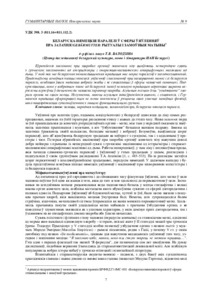Please use this identifier to cite or link to this item:
https://elib.psu.by/handle/123456789/17790Full metadata record
| DC Field | Value | Language |
|---|---|---|
| dc.contributor.author | Валодзіна, Т. В. | - |
| dc.date.accessioned | 2016-11-23T12:15:13Z | - |
| dc.date.available | 2016-11-23T12:15:13Z | - |
| dc.date.issued | 2016 | - |
| dc.identifier.citation | Вестник Полоцкого государственного университета. Серия A, Гуманитарные науки. - 2016. - № 9. – C. 7-16. | ru_RU |
| dc.identifier.issn | 2070-1608 | - |
| dc.identifier.uri | https://elib.psu.by/handle/123456789/17790 | - |
| dc.description | Belarusian-German Parallels in the Sphere of Perception of Zalatnik/ Gebärmutter: Rituals and Charm Motifs T. Valodzina | ru_RU |
| dc.description.abstract | Еўрапейскія заклінанні пры хваробах органаў жаночага нізу выяўляюць непасрэдную сувязь з грэчаскімі заклінаннямі ад істэры/мітры і старажытнаславянскімі апакрыфічнымі малітвамі ад дъны. У той жа час беларуская этнамедыцынская традыцыя мае шэраг паралеляў з заходнеславянскай. Прадстаўлены асноўныя пазіцыі нямецкіх уяўленняў і заклінанняў пры захворваннях маткі і іх беларускія паралелі, асаблівая ўвага надаецца вобразу жабы і яе сімвалізацыі ў сферы чалавечай саматыкі. Падкрэслiваецца, што у вобразным плане ад беларускіх замоў немецкую традыцыю адрознівае выразна акрэслены агрэсіўны ў дачыненні да чалавека характар хваробы. Агульным месцам ёсць “усаджванне” хворага органа на сваім месцы. Несумненна, маючы агульныя індаеўрапейскія вытокі, і славянскія, і Германскія традыцыі сфарміравалі тым не менш комплексы ў рэчышчы сваіх уласных замоўных фондаў, што пацвярджаецца супастаўленнямі з іншымі функцыянальнымі групамі.= European incantations connected with the diseases of the organs of the female bottom reveal a direct link between Greek incantations against «істэры» (‘hystera’)/«мітры» and old Slavic apocryphal prayers against «дъны». at the same time Belarusian ethnomedical tradition has a number of parallels with the West Slavic one. In this article the main points of German perception and incantations connected with the diseases of the Uterus and their Belarusian parallels are presented, special attention is paid to the image of toad and its symbolization in the sphere of human somatics. In the figurative plan from Belarusian charms a German tradition differs in the distinctly outlined aggressive towards a person nature of the disease. Commonplace is the “returning” of the injured organ on its place. Undoubtedly having common Indo-European origin, both Slavic and German traditions nevertheless formed complexes in the sphere of their own funds of charms, which is confirmed by comparisons with other functional groups. | ru_RU |
| dc.language.iso | be | ru_RU |
| dc.publisher | Полоцкий государственный университет | ru_RU |
| dc.relation.ispartof | Веснік Полацкага дзяржаўнага ўніверсітэта. Серыя А, Гуманітарныя навук | be_BE |
| dc.relation.ispartof | Herald of Polotsk State University Series A, Humanity sciences | en_EN |
| dc.relation.ispartof | Вестник Полоцкого государственного университета. Серия A, Гуманитарные науки | ru_RU |
| dc.relation.ispartofseries | Серия A, Гуманитарные науки;2016. - № 9 | - |
| dc.rights | open access | ru_RU |
| dc.subject | замовы | ru_RU |
| dc.subject | народная медыцына | ru_RU |
| dc.subject | залатнік/істэра | ru_RU |
| dc.subject | беларуска-нямецкія паралелі | ru_RU |
| dc.subject | Charms | ru_RU |
| dc.subject | folk medicine | ru_RU |
| dc.subject | the uterus/hystera | ru_RU |
| dc.subject | Belarusian-German parallels | ru_RU |
| dc.title | Беларуска-нямецкія паралелі ў сферы ўяўленняў пра залатнік/Gebärmutter: рытуалы і замоўныя матывы | ru_RU |
| dc.type | Article | ru_RU |
| dc.identifier.udc | 398. 3 (811.16+811.112.2) | - |
| Appears in Collections: | 2016, № 9 | |
Items in DSpace are protected by copyright, with all rights reserved, unless otherwise indicated.
